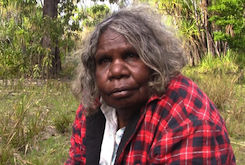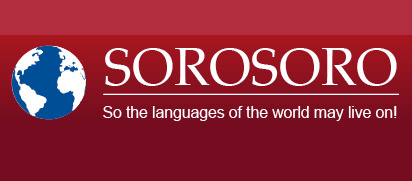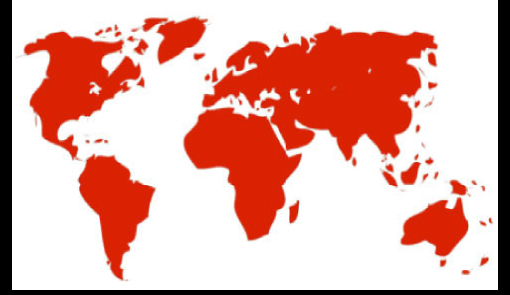Print  |
|

Dalabon
Page created by Dr Maïa Ponsonnet – Centre for Research and Documentation on Oceania (CNRS, Marseille) & Australian National University (Canberra).

Maggie Tukumba, member of the Weemol community, co-author of the first Dalabon dictionary. Credits: Matthieu Rabusseau.
Data on the Dalabon language
Alternative names:
Nowadays the name « Dalabon », used by the speakers themselves, is used almost unanimously. Earlier articles do mention other terms such as Ngalkbon, Fangbon, or Buwan, however, including different spelling variations.
Main dialects:
The current state of Dalabon makes the study of dialects difficult. Speakers mention a distinction between two different types of speech, dalabon-djurrkdjurrk (literally, « fast », « lively ») and dalabon-murduk (literally « strong », that is, regarding a language, « articulate »). Yet no significant dialectal difference has been identified, and given the number of speakers, such issues have become rather hard to address.
Geographical area:
Nowadays speakers of Dalabon live in the Weemol, Beswick and Barunga communities located east of the town of Katherine, in Northern Territory. They live in a region known as Arnhem Land, often considered as a bastion of Aboriginal culture partly because most of the area covers land that was legally « returned » to the Aboriginal groups.
The speakers of Dalabon used to be concentrated around the area of the future Weemol community, as well as north of this area, i.e. southeast of Arnhem Land. When farmers eventually colonized that area, the populations living there were deported to settlements (villages created and managed by the government) closer to Katherine. Some speakers returned to Weemol in the 70s, while others remained in the old Beswick and Barunga settlements.
Classification:
Dalabon is an Australian language of the Gunwinyguan family.
Linguists classify the Australian language families into two separate groups, the Pama-Nyugan languages on one side, with the largest number of languages, and the Non-Pama-Nyugan languages on the other. Dalabon belongs to the second category, smaller in number, and essentially represented in the North of the continent.
Number of speakers:
If by « speaker » one means a person who speaks Dalabon as their first mother language, then the number of speakers of Dalabon nowadays narrows down to 3. If census includes people who speak fluent Dalabon but learned it later, as a second or third language, then Dalabon counts at least 6 or 7 speakers. The number keeps rising if semi-speakers are counted in; people who speak Dalabon though not as fluently: up to a dozen, probably, which includes younger people (under age 40). If census includes people with notions of Dalabon, who understand it at least partially but are unable to speak it (whether shyness, lack of practice, etc.), then the number of people who speak Dalabon fianlly reaches a few dozens and includes younger people in their twenties.
Language status:
Dalabon bears no official status, and it is not a language of communication either. Over the years local schools ran sporadic teaching programs organized by a Language Centre in Katherine (Diwurruwurru-Jaru Corporation, government-supported). But these practices remain fragile and support from the government is only limited (see article by Maïa Ponsonnet on the Sorosoro blog). Nevertheless, Dalabon – as numerous Australian languages in a similar situation – does benefit some degree of prestige in that it’s associated to the indigenous cultural heritage, often put forward both in the official discourse (along with a little funding) as well as in some form of folk ideology. This stands as a progress in comparison to the time, prior to the 60s, where local languages were viewed as useless particularisms and an impediment to the integration of indigenous languages. Yet the way Aboriginal cultures and communities are regarded remains ambivalent, and linguistic diversity is still too often considered as a handicap.
This situation applies not only to Dalabon but also to most of the languages as endangered as Dalabon. On the other hand, Dalabon has acquired a particular status in regards to research. Both because of a certain number of interesting features and random events leading to some form of « snowball effect », Dalabon has kept drawing the attention of a growing number of linguists since the early 2000s, researchers who now work as a team, stirring both the interest of scholars and the speakers themselves. Dalabon appears to be gaining authority in research networks, as did important Australian languages such as Warlpiri, for example. For the speakers, semi-speakers and passive speakers of Dalabon, the interest showed by outsiders and the associated prestige has acted as a catalyst of enthusiasm, to the point that nowadays more and more members of the Dalabon community are willing to take part in the documentation process of their own language.
Vitality & Transmission:
The Dalabon language is extremely endangered, both considering the number of speakers and the level of transmission of the language. None of the mother language speakers are under 60. The youngest passive speakers are in their twenties, and chances are that younger teenagers know even less of their grandparents’ (or great-grandparents’) language. Dalabon has been replaced by a creole language, Kriol (more specifically a variety known as Barunga Kriol). The descendants of Dalabon speakers now speak Kriol, which they claim as their own language, and also English, which is spoken at school, on TV, etc.
The active speakers of Dalabon rarely find themselves together, so situations of spontaneous conversation in Dalabon are also very rare. Still, active speakers do express themselves in Dalabon, they « speak around » so to speak, and therefore do hand over some degree of knowledge of the language – though this kind of learning mode remains limited. Ongoing documentation activities create additional context that is favourable to the learning of Dalabon. They take place on a regular basis, since several linguists work in the area and can actually be present once or twice a year. Also, passive speakers, even including very young children, show some interest in these activities and insist to attend or take part in the sessions.
Media & literature:
Dalabon is totally absent of media, including local or specialized media. As mentioned above, the teaching of this language in school remains an unsteady practice, occasional in any case. On the other hand, the linguists of the Language Centre in Katherine have recorded and archived local stories in Dalabon, or videos on arts and craft techniques, food gathering, etc. The audio-visual archives of the Australian Institute of Aboriginal Studies in Canberra are also home to older recordings of very rich content.
These documents are rather difficult to access at this point, and so is the rest of the work conducted on Dalabon so far. Only the First Dictionary of Dalabon (Evans, Merlan & Tukumba, 2004) has been more widely distributed. But the team of linguists specialized in Dalabon is working towards a broader output of these corpora, especially by having them accessible online on the Endangered Languages Archive website (ELAR, London).
Ethnographic & historical observations
The elder Dalabon often claim a cultural association with other neighbouring linguistic groups, namely the Mayali language groups, Kune (pronounced « Guney »), dialects of the Bininj Gun-Wok language (Gunwinyguan languages close to Dalabon, historically located west and north of the Dalabon region), and Rembarrnga (Gunwinyguan language of another branch, historically located east). The Dalabon used to share myths and ceremonies with these linguistic groups, and there were exchanges between them in terms of rituals, marriage, etc.
In the first half of the 20th century, colonization and displacement of the populations to the settlements modified the structure of these cultural networks, gathering Mayali, Rembarrnga, Jawoyn and Dalabon in the same villages. Mayali gained speakers as well as prestige, and reached the status of regional lingua franca. The Jawoyn (Gunwinyguan language of another branch, historically southwest of Dalabon) also gained cultural and political value. To some extent, however, Dalabon stayed behind. Nowadays speakers of Dalabon show some sense of pride accordingly to the specificity of their language, the interest drawn from linguists, and its value on a cultural level.
In the 1970s, a shift in government policy allowed the Dalabon to return to their traditional land, creating the Weemol community. This very small community (of under 100 people) was then home to a whole generation of Dalabon mother-tongue speakers who communicated in their own language, using Kriol only for communication with the young. These speakers disappeared one after the other along the 1990s, leaving only a few isolated speakers who now rarely have the chance to communicate in their language.
Ethnographic observations
There are no monographs on the Dalabon. Australian anthropologist Kenneth Maddock worked among them in the 1960s and did produce considerably rich articles, although never a whole volume specifically devoted to the Dalabon culture.
Linguistic observations
Like all Non-Pama-Nyungan languages, Dalabon is a prefix language. The verbs use prefixes marking their subjects and objects, while in Pama-Nyungan languages, this function is fulfilled by suffixes. Another feature that Dalabon shares with the other Gunwinyguan languages, as well as other close language families, is being a polysynthetic language. This means that the units producing sense, called morphemes, can add up to each other, according to specific rules of course, eventually forming very long words. Dalabon takes this practice even further than other neighbouring languages. On top of that, morphemes are hardly modified when they’re associated to each other: they join in a sequence, so to speak, just like pieces of Lego would.
Among the other very interesting features of Dalabon is a prefix and pronoun system that enables to point out genealogic distinctions among the people referred to: in Dalabon, for instance, I’ll say burrah-ngun to signify that my two sisters are eating, and keh-ngun to signify that my sister and my mother are eating. The language marks the generational shift between the two people in question.
A few words in Dalabon
walu-no [waluno] the absolute law, the rules governing the world
nayunghyungki [najuŋɁjuŋɡi] mythical ancestors
wirridjih [wiriȡiɁ] taboo(s)
yang [jaŋ] language, speech, what one says
kirribruk [kiribɹuk] true, real, honest, fair, generous
wokan [wokan] speak, talk, tell, name, evoke, communicate
men-no [mɛnno] conscience, the thoughts of a living creature
biyi [bi:] man (men)
kirdikird [kɨɖɨkɨɖ] woman (women)
wurdurd [wuɖuɖ] child (children)
wurrhwurrungu [wurɁwuruŋu] the elders
wadda-no [wat:ano] camp, home
Sources, links & bibliography
Evans, N., F. Merlan and M. Tukumba, A First Dictionary of Dalabon. Maningrida Arts and Culture: Bawinanga Aboriginal Corporation.
Ponsonnet, Maïa. 2009. « Aspects de la subjectivité intellectuelle en langue dalabon (Australie du Nord) ». Online review Texto! Directed by François Rastier (CNRS). Online French translation, originally published in Australian Aboriginal Studies 2009(1).
Please do not hesitate to contact us should you have more information on this language: contact@sorosoro.org








